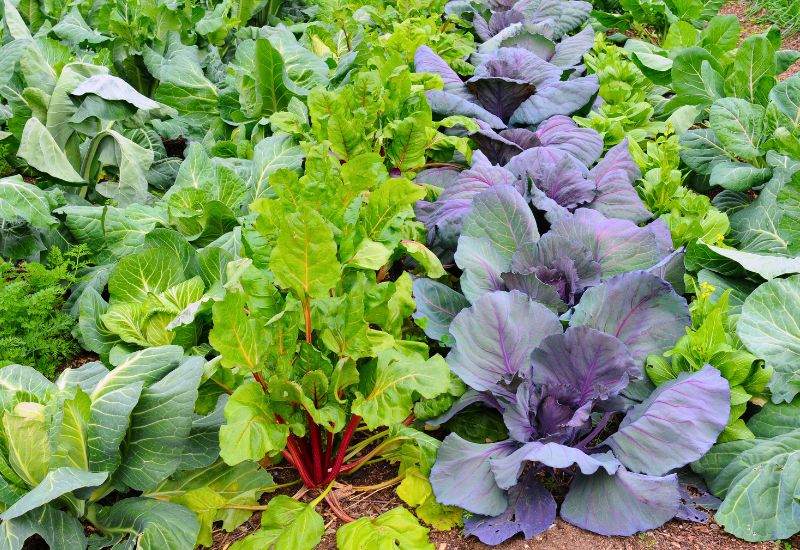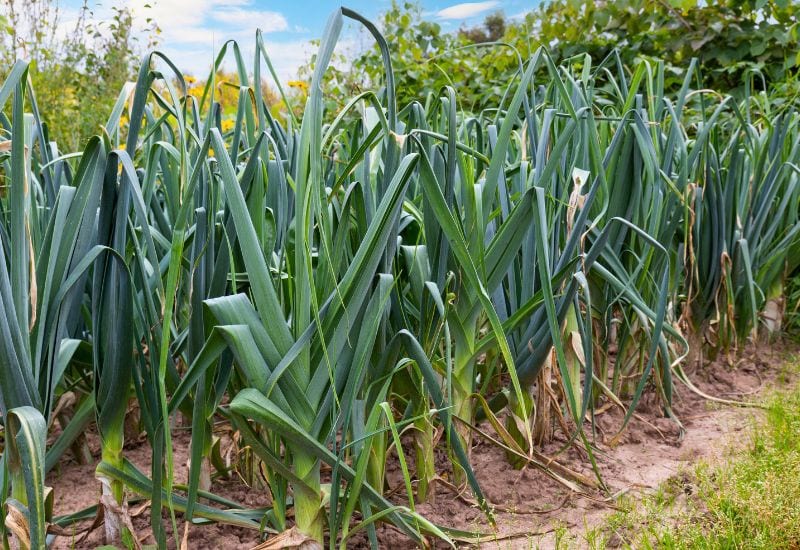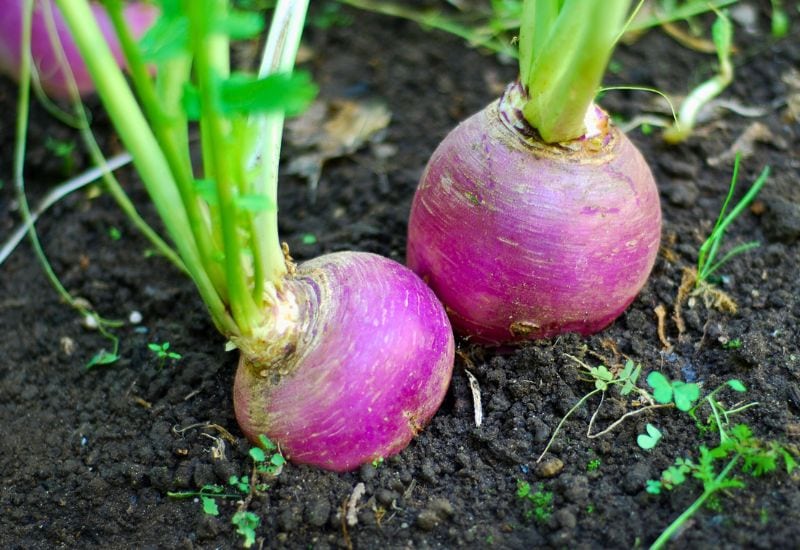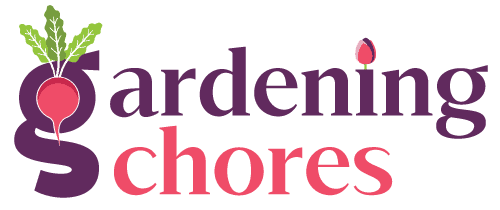
You don’t want to waste your backyard beds in fall and winter? And why should you? There is no reason to buy groceries in the cold season – you can still grow many crops. But maybe you don’t want to run risks? Then you are wise! Or do you live in a cold climate zone? Then, you must choose fail-proof and hardy varieties that can grow and thrive in low temperatures, even under a white mantle of snow…
Plant these strong, cold hardy and fail proof vegetables in your garden in fall and you will have greens to harvest till spring. And some actually taste better if temperatures drop to freezing!
1: Kale (Brassica oleracea var. sabellica)

An absolutely safe and easy to grow, high yield vegetable to grow in fall and winter is definitely kale! It can tolerate freezing, almost Arctic temperatures down to 10°F (or -12°C)! It keeps your veggie garden green even in snow, and actually, it becomes sweeter if it gets frost!
You can choose from many varieties, like Winterbor, Red Russian, Lacinato (Dinosaur Kale), but all are rich in fiber, antioxidants, calcium, vitamins C and K, iron, and a wide range of other nutrients, with a strong but heartwarming flavor that’s just ideal for cold, windy, rainy and snowy nights.
Plant kale seedlings at a distance of 12 to 18 inches (30 to 45 cm).
2: Spinach (Spinacia oleracea)

Very popular, low maintenance and with a long harvest season; you can keep cutting spinach down through fall and winter, and in a few weeks, it will grow back! It’s also fast, and very cold hardy indeed, as it withstands temperatures of 20°F (-6°C), or even lower. There are many varieties as well, like Winter Bloomsdale, Giant Winter, Tyee, but they are all sweet and nutritious.
In fact, we all know spinach for its iron content, but it has other minerals too, like calcium, magnesium and potassium, as well as carotenoids, vitamin C, vitamin B12, vitamin K and folic acid. You won’t need those supplements any more, all through fall and winter!
Sow spinach directly in your veggie garden 2 inches apart (5.0 cm) and with rows 12 inches apart (30 cm).
3: Carrot (Daucus carota)

Did you know that carrots can survive temperatures as low as 15°F (or -9.0°)? And, if you mulch, even lower! So, you’ll have lots of these orange roots to go by from fall till you plant a new crop in spring… Actually, they will taste better in the cold season, because they sweeten with frost! Anyway, they are not just orange, there are varieties in red, yellow, purple, off white… Enough to keep your dinner table colorful and festive for months!
We all know that carrots are good for our eyes, thanks to beta carotene, but it also has good quantities of vitamin A, vitamin C, vitamin K, calcium, magnesium, iron, sodium and potassium.
Sow carrots directly in your garden and then thin them out as necessary as they grow – that’s how you get baby carrots!
4: Leek (Allium ampeloprasum)

A typical fall and winter vegetable, leek grows strong and it gives you no problems at all, not even with pests (only leek moth), so it is very safe to grow in the cold season. In fact, don’t worry about frost, as it doesn’t mind temperatures down to 20°F (-6.0°). Mulch them to give them some extra protection, whichever variety you choose, like Bandit, Blue Solaise, Winter Giant.
On top of its sweet flavor (and you can use it instead of onions!), this humble vegetable is packed with nutrients! You will have phosphorus, magnesium, calcium, potassium, as well as folate, vitamin C, vitamin A (both types), vitamin B6, vitamin K and carotene (yes, like carrots!) It would be a shame not to plant it in your garden!
Plant leeks 6 to 8 inches apart (15 to 20 cm), but baby leeks only 4 inches (10 cm).
5: Cabbage (Brassica oleracea var. capitata)

Cabbage actually needs frost to form its big round heads; the leaves close up just to protect themselves from it. So, the best and safest season to grow it is from fall to winter, as it takes 60 to 100 days to be ready to harvest. But don’t worry about snow and frost, it feels fine at temperatures that can drop to 20°F (-6.0°C). There are then so many varieties, like Savoy (my favorite), January King, Copenhagen Market, as well as colorful and ornamental ones for your front garden. And you can eat those too!
Cabbage will give flavor to any dish you use it in, as well as massive quantities of Vitamin K and C, as well as folate, calcium, potassium, magnesium and iron.
The spacing to plant cabbages is 12 to 18 inches (30 to 45 cm), depending on the variety.
6: Turnip (Brassica rapa subsp. rapa)

Another great root vegetables for your fall and winter backyard is turnip, great in stews and indeed a cold season classic. Tolerant to temperatures of 20°F (-6.0°), you can harvest it till spring comes, and don’t forget the leaves too: they are really delicious! Good varieties to choose from are purple Top White Globe, Golden Ball, Tokyo Cross, but feel free to pick any other.
Turnips are rich in Vitamin C, Vitamin B6, sodium, magnesium and some calcium, so they will add more than just their flavor to your garden.
Sow turnips directly outdoors and thin them out as necessary, like you do with carrots.
7: Swiss Chard (Beta vulgaris L. var. cicla)

One of my all-time favorite leafy vegetables for fall and winter is Swiss chard, which can tolerate temperatures dropping to 15°F (-9.0°C), and you can harvest it all through the season, as it grows back when you cut it. It can also add color to your dinner plate, with red ribbed varieties like Magenta Sunset, Rhubarb and Vulcan, or pick fully green, but still delicious ones like Fordhook Giant, Bright Lights, Lucullus.
Boiled, sautéed with a bit of butter or margarine, or added to other dishes, its sweetness is mouth-watering, but it is also very good for your health. In fact, it contains lots of fiber, vitamin K, vitamin A, oxalates, magnesium (lots) and sodium.
Sow Swiss chard directly in your garden, about 2 inches apart per seed (5.0 cm), then thin them out as they grow (and eat the baby chard!)
8: Beet / Beetroot (Beta vulgaris subsp. vulgaris ‘Conditiva Group’)

Talking of color (to warm you up on winter days), what’s better than beet? This root vegetable grows well to temperatures of 20°F (-6.0°C), it is easy to grow and trouble free – true, some people love it, others hate it, and for me, it’s an acquired taste, but now I fry it with soy sauce as a meat replacement! It too has some varieties to pick from, like Detroit Dark Red, Lutz Green Leaf, Golden (this last one is of an amazing bright yellow inside)! The leaves are nice too, a bit like cabbage…
Roasted or in salads, beet also helps you keep fit, as it’s a source of fiber, folate, vitamin C, iron, potassium and manganese.
Sow beets directly in your vegetable bed and thin them out as they grow. But eat them all, the tiny ones are so tender!
Keep Growing and Keep Harvesting Healthy Vegetables in Fall and Winter
there are other vegetables you can safely grow in fall and winter too, like garlic, onions, and all the Asian leafy veggies, like pak choi, most brassicas (Brussels sprouts, for example): So, there’s no reason to keep your back garden empty and forlorn, even under the snow. And though these varieties will keep you harvesting without running any risks, they will give you so much to cook and to keep healthy till spring comes!

Written By
Amber Noyes
Amber Noyes was born and raised in a suburban California town, San Mateo. She holds a master’s degree in horticulture from the University of California as well as a BS in Biology from the University of San Francisco. With experience working on an organic farm, water conservation research, farmers’ markets, and plant nursery, she understands what makes plants thrive and how we can better understand the connection between microclimate and plant health. When she’s not on the land, Amber loves informing people of new ideas/things related to gardening, especially organic gardening, houseplants, and growing plants in a small space.

Wow, I did not know that kale can be grown and even thrive in the winter time! Good to know for future reference.